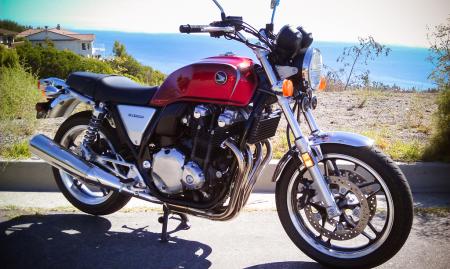2013 Honda CB1100 Review - Quick Ride - Motorcycle.com
Honda is highly regarded as a leader in motorcycle technology. It shocked the world in 1969 with the introduction of the first large-displacement four-cylinder engine (CB750), and it was the first manufacturer to fit electronic fuel injection and a turbocharger to a production two-wheeler (1985 CX500 Turbo). More recently, Big Red created the first dual-clutch automatic transmission (2010 VFR1200F).
But this pursuit of forward-looking technology overshadows the rich legacy of Honda’s history. So, while several other manufacturers exploit nostalgic-minded riders with models such as the Triumph Bonneville, Sport Classic Ducati s, the updated Moto Guzzi V7s and most Harley s, Honda has basically ignored the retro market.
But that changes with the introduction of the 2013 CB1100, an homage to Honda’s class-leading multi-cylinder offerings from the 1970s and early ’80s. The new CB features several design cues from that era, including its tank shape, chrome fenders, round headlight, instruments with chrome bezels and, most importantly, a beautiful air-cooled four-cylinder powerplant – just like a UJM (Universal Japanese Motorcycle) from 30-odd years ago.
American Honda took an innovative step in giving us a short sample ride on the CB1100 a few days before its 2013 models were even announced. Although our ride was admittedly short, we got a fairly good idea of how the CB performs in a variety of environments.
Nice To Meet You
The CB feels much smaller than its considerable 1140cc displacement would lead you to believe. Its 31.3 inch seat height and narrow midsection makes it feel like it could be a 750cc-sized roadster even though it scales in with a 540-pound curb weight (549 with optional ABS). The ergonomic layout is a bit foreign to riders accustomed only to modern bikes. The low seat and its flattish layout allow plenty of fore/aft room to suit riders of all sizes. The one-piece handlebar is set at an angle that requires just a slight bend forward. Modestly rear-set pegs are located comfortably below a rider’s butt.
Instrumentation is provided by traditional twin dials for the analog speedo and tach that bookend a small LCD info screen containing two trip meters and a clock but no gear-position indicator. Both hand levers feature adjustable spans. Optional accessories include heated grips, a luggage rack and a chrome headlight bucket.
The CB proves to be easy to ride from the first turn of its wheels. Clutch pull is fairly light, and the low-strung motor pulls smoothly at revs barely into the quad digits. In fact, the CB can pull away from a stop with only clutch modulation – the engine’s low-end response means there’s no need for throttle input if so desired.
With a much less oversquare bore and stroke than contemporary sporting machines (73.5 x 67.2mm), it’s able to tug cleanly from just 2000 rpm and ramps up quite strongly just 1000 revs later. Peak torque of 67.9 ft-lb (factory crankshaft rating) arrives at 5000 rpm, so there’s ample thrust without having to search the tachometer for it. Despite the CB’s modern double-overhead cam and 4-valves-per-cylinder architecture, horsepower crests with a rather modest 85.3 at 7500 revs. Its maximum acceleration feels like about 75 rear-wheel horses.
While its peak power might be a little underwhelming, the engine never strains to provide good thrust and throttle response is smooth yet deliberate. Its 5-speed gearbox is crisp and sure. Vibration can be felt above 5000 rpm, but higher revs are almost never required. Its rev limit is hit at 9000 rpm. The moaning sound from the airbox between the knees brings back memories of vintage CBs, but the exhaust is a little too subdued for our tastes. Is Kerker still in business…?
Would we appreciate more power from an engine this large? Certainly, but consider this: Ray Blank, the recently retired Senior VP of motorcycles for American Honda, put on 4000 miles of the 6000 logged on the Japanese-spec CB1100’s odometer used for internal evaluation. Since Blank is known to be quite a horsepower junkie, that’s speaking volumes.
Conservative steering geometry (27.0-degree rake, 114mm trail) suggests ponderous handling qualities, but the CB1100 proves to be very easy to manage, whether flipping a U-turn in a parking lot or cutting up commuter traffic. Credit its relatively skinny tires (110/80/-18, 140/70-18) for the CB’s exceedingly linear and intuitive steering response. To borrow an expression from the Brits, it’s a doddle to maneuver.
Brakes are another huge upgrade over the CB’s progenitors, using a pair of 296mm rotors and four-piston calipers up front that offer way more bite than anything from the 20th century. The front brake rotor mounts directly to the wheel like some BMWs and Honda’s own NC700. Out back, a fairly large 256mm rotor and single-piston caliper aid speed retardation without fuss. An ABS system is a $1,000 upgrade over the $9,999 standard model.
Conclusion
The CB1100 is a surprising breath of fresh air considering its inspiration drawn from Honda’s musty past. Similar in ways to the Triumph Scrambler we recently reviewed, the retro CB stands apart from anything resembling a rival. Its throwback design with the benefits of modern engineering proves the timeless quality of the historic CB series, even in the context of contemporary motorcycles.
The Big Four Japanese manufacturers rarely look back at their past to inspire something modern, but Honda has demonstrated that it could be convincingly achieved. Now all that’s left is to find out if there’s a market in America for riders looking for a nostalgic Japanese ride.
Related Reading
2013 Honda Models Announced
2012 Triumph Scrambler Review
2012 Honda NC70X Review - Video
2013 Kawasaki Early-Release Models
2012 Moto Guzzi V7 Lineup Review
Ryca CS1 Review
2011 Honda CB1000R Review
2011 Literbike Streetfighter Shootout
2010 Honda CBF1000 Review
2010 Kawasaki Z1000 Review
2009 Triumph Thruxton Review
2009 Triumph Bonneville Review
Ducati GT1000 Sport Classic Road Test
More by Kevin Duke

































Comments
Join the conversation